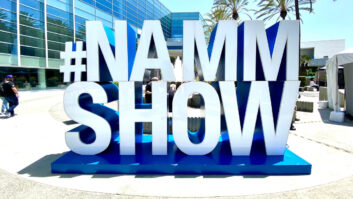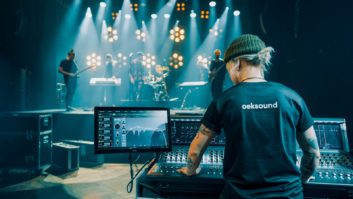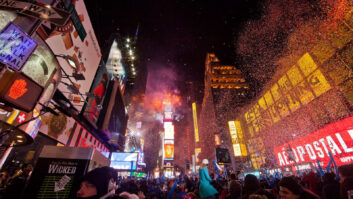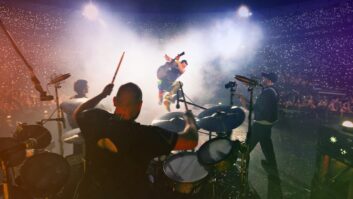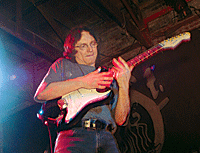
Performing live, Sonny Landreth is a bolt of Louisiana lightning, feeding off the crowd’s energy and radiating high-octane bon temps blues. Landreth strums, slaps, hammers and shakes his guitar to produce fearful shards and sublime textures. A deft picker (a lá Chet Atkins) and an incredibly soulful slide player (in the Robert Johnson style), Landreth has taken Delta blues to new dimensions. Deeply influenced by his bayou homeland, he communicates spirit and passion through his playing, which combines grit and finesse. It’s no wonder Landreth’s guitar-gumbo gris gris often causes guitarists in the audience to just laugh in amazement.
After five studio albums as a leader and numerous sessions as a sideman, it was time to capture Landreth where he is most at home — onstage. His latest CD, Grant Street (Sugar Hill Records), documents the blazing guitarist and soulful songwriter with his crack rhythm section of drummer Kenneth Blevins and bassist Dave Ranson on a hot night at the Grant Street dancehall in Lafayette, La. Multiple Grammy-winning engineer Tony Daigle handled all tracking duties on the CD. Daigle’s Pro Tools-based Electric Comoland Studios (named after former Beausoleil guitarist Tommy Comeaux, who was killed in a bicycling accident in 1997) is down the road from Grant Street. Landreth tracked and mixed his previous Sugar Hill album, The Road We’re On, there.
Landreth and Daigle both have long histories at Grant Street: Landreth first played there as a member of Clifton Chenier’s Red Hot Louisiana Band when the venue opened, and Daigle has performed there (as a guitarist and percussionist) numerous times and recorded countless acts from Grant Street’s stage.
Though Daigle generally relies on the Pro Tools TDM systems at Electric Comoland to capture Landreth’s live gig, he rented two Otari RADAR 24 digital recording systems (with Nyquist A/D converters) because of their robust reliability. Daigle is especially proud of his collection of custom Brent Averill, PreSonus and vintage Neve preamp modules, many of which he brought to Grant Street for the live recording project.
“We just carted our gear down to Grant Street and set up in a back room. Any microphone you put up in front of Sonny’s amps is gonna sound fine,” Daigle says, only half-jokingly.
A master of open and alternate guitar tunings, Landreth travels with just two guitars: a Gibson Les Paul and a Fender Stratocaster. Landreth’s guitar tech, Jason Swallow, handles guitar care and tunings while Landreth is engaging the crowd. The axe-wielder plays through two amplifiers — a Matchless Chieftain and a Dumble Overdrive Special — each one feeding a Fender cabinet with 2×12 speaker cones.
Daigle tracked Landreth’s guitar with a combination of five inputs: a Sennheiser 421 six inches from the top speaker and a Royer 121A ribbon microphone six inches from the bottom speaker of the cabinet driven by the Matchless amp. For the cabinet being fed by the Dumble amp, he used the 121A 12 inches from the top speaker and a Neumann KM84 48 inches from the bottom speaker. Daigle also used a Countryman DI feed through an Apogee Trak 2 A/D converter on Landreth’s guitar.
Tony Daigle, mixing it up
photo: Travis Gauthier
Recording Landreth’s vocal with a Shure Beta 57 proved to be more difficult. “Sonny has a very sensitive voice and he plays loud guitar. It’s very difficult to capture both accurately,” Daigle explains. “I was getting more guitar than vocals in the vocal mic!” The solution was to blend it with room mics: “I think we got our best vocal sound ever,” he says.
Daigle used his own five-mic technique for capturing the audience: “I use two AKG 414s at each wing of the stage, facing the audience on 6-foot-high mic stands. I use another single mono microphone centerstage on a 1-foot microphone stand facing the audience. I also hung two Electro-Voice RE-15s about mid-room.”
After using the RADAR system for recording, Daigle took the .WAV files back to Electric Comoland and mixed in Pro Tools. Co-producers Bobby Field, Landreth and Daigle listened back through Genelec 1030 near-field monitors.
“This was a tricky mix,” Daigle explains. “I had actually spent quite a few days on the mix and we all thought it sounded good. Then I discovered a different method of phasing the room mics to make the room feel more three-dimensional. So I had to go back to the previous mixes and reset the room mics on all of the songs we thought were done. It just made it sound more like Grant Street.”
“There’s something about that moment you step onstage and you tap into the energy of the crowd and everything just goes up to another level,” Landreth comments. “I wouldn’t be able to play like that if I were sitting on my couch.”




